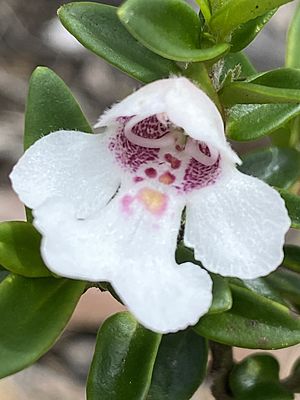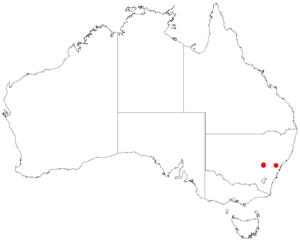Prostanthera gilesii facts for kids
Quick facts for kids Prostanthera gilesii |
|
|---|---|
 |
|
| Scientific classification | |
| Genus: |
Prostanthera
|
| Species: |
gilesii
|
 |
|
| Occurrence data from AVH | |
Prostanthera gilesii is a special kind of flowering plant. It belongs to the Lamiaceae family, which includes mint plants. This shrub is only found in one place: the Mount Canobolas area in New South Wales, Australia. It's a small, bushy plant that spreads out. Its leaves smell nice and are shaped like narrow eggs. The flowers are white or yellowish-white. They have cool purple or dark pink marks inside, and light orange spots on the outer parts.
Contents
About the Mount Canobolas Mint Bush
The Prostanthera gilesii is a compact, spreading shrub. It usually grows up to 1 meter (about 3 feet) tall. Its small branches are mostly round and a bit hairy.
Leaves and Flowers
The leaves of this plant smell good. They are shiny dark green on top and lighter underneath. They feel smooth and are shaped like narrow eggs. Each leaf is about 15 to 26 millimeters long and 6 to 10 millimeters wide. They grow on a short stalk called a petiole, which is 1 to 2 millimeters long.
The flowers grow one by one where the upper leaves meet the stem. At the base of each flower, there are tiny leaf-like parts called bracteoles, about 3 to 3.5 millimeters long.
The green sepals form a tube about 2.5 to 3 millimeters wide. They have two main parts, or lobes. The lower lobe is 5 to 6 millimeters long and 3.5 to 4 millimeters wide. The upper lobe is 5 to 6 millimeters long and 4.5 to 5.5 millimeters wide.
The petals are white or yellowish-white and are 12 to 15 millimeters long. They form a tube that is 7 to 9 millimeters long. Inside this tube, you can see purple or dark pink markings. The central lower petal has light orange marks. It is 10 to 11 millimeters long and 4 to 4.5 millimeters wide. The side petals are 7 to 8 millimeters long and 4 millimeters wide. The upper petal is 4 to 5 millimeters long and 8 to 9 millimeters wide, with a small notch at the top. This plant usually flowers in November and December.
How it Got its Name
Prostanthera gilesii was officially described in 2015. Two scientists, Barry Conn and Trevor Wilson, published its description. They used notes from an earlier, unpublished description by George Althofer.
The second part of its name, gilesii, was suggested by Althofer. It honors William E. Giles, who first found this plant in the 1940s. This way of naming plants with two parts is called binomial nomenclature.
Where it Lives
This special mint bush grows in forests. These forests are mostly filled with a type of tree called Eucalyptus dalrympleana. The Prostanthera gilesii is only found in the Mount Canobolas State Conservation Area. This means it has a very small natural home.
Protecting This Plant
The Prostanthera gilesii is listed as "critically endangered." This is under the New South Wales Government's Biodiversity Conservation Act 2016. "Critically endangered" means it is at very high risk of disappearing forever.
Threats to the Plant
There are several reasons why this plant is in danger:
- Small Population: There are not many of these plants left.
- Fire: The way fires happen in its habitat is not good for the plant.
- Weeds: Other plants, called weeds, are invading its home.
- Pigs: Wild pigs can disturb the area where it grows.
- Illegal Collection: Some people illegally take parts of the plant.
Scientists and conservationists are working to protect this unique Australian plant.

